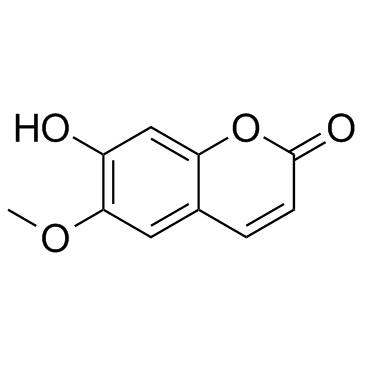Scopoletin (Gelseminic acid) (Synonyms: Esculetin 6-methyl ether, 7-Hydroxy-6-methoxycoumarin, 6-Methoxy-7-hydroxycoumarin, NSC 405647) |
| Catalog No.GC31699 |
Scopoletin (Gelseminic acid) is an inhibitor of acetylcholinesterase (AChE).
Products are for research use only. Not for human use. We do not sell to patients.

Cas No.: 92-61-5
Sample solution is provided at 25 µL, 10mM.
Scopoletin is an inhibitor of acetylcholinesterase (AChE).
Scopoletin (SCT) is identified as a putative inhibitor of acetylcholinesterase (AChE). Scopoletin enhances the K+-stimulated release of ACh from rat frontal cortex synaptosomes, showing a bell-shaped dose effect curve (Emax: 4 μM) [1]. Scopoletin inhibits PC3 proliferation by inducing apoptosis of PC3 cells. The IC50 of Scopoletin for inhibiting PC3, PAA (human lung cancer cell), and Hela cell proliferation is (157±25), (154±51), and (294±100) mg/L, respectively. Scopoletin induces a marked time- and concentration-dependent inhibition of PC3 cell proliferation. Scopoletin reduces the protein content and decreases the acid phosphatase activity (ACP) level in PC3 cells in a concentration-dependent manner. Cells treated by Scopoletin show typical morphologic changes of apoptosis by light microscope, fluorescence microscope, and transmission electronmicroscope. Apoptosis rate is 0.3 %, 2.1 %, 9.3 % and 35 % for Scopoletin 0, 100, 200, and 400 mg/L, respectively, and cells in G2 phase decrease markedly after being treated with Scopoletin[2].
Scopoletin (2 μg, i.c.v.) increases T-maze alternation and ameliorated novel object recognition of mice with scopolamine-induced cholinergic deficit. It also reduces age-associated deficits in object memory of 15-18-month-old mice (2 mg/kg sc). Mice injected with 2 μg Scopoletin show an increased alternation rate of 71.3±2.5%[1].
[1]. Hornick A, et al. The coumarin Scopoletin potentiates acetylcholine release from synaptosomes, amplifies hippocampal long-term potentiation and ameliorates anticholinergic- and age-impaired memory. Neuroscience. 2011 Dec 1;197:280-92. [2]. Liu XL, et al. Effect of Scopoletin on PC3 cell proliferation and apoptosis. Acta Pharmacol Sin. 2001 Oct;22(10):929-33.
Average Rating: 5 (Based on Reviews and 11 reference(s) in Google Scholar.)
GLPBIO products are for RESEARCH USE ONLY. Please make sure your review or question is research based.
Required fields are marked with *




















